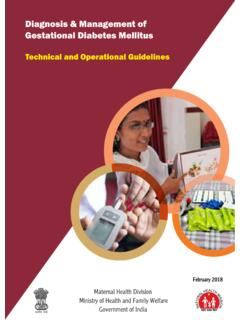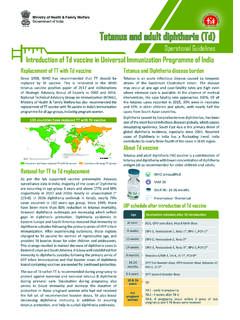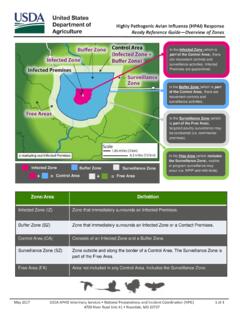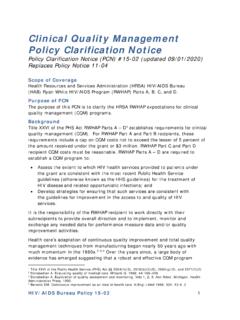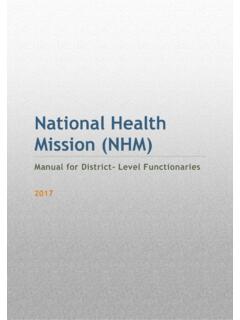Transcription of National Health Mission (NHM)
1 National Health Mission (NHM) About National Health Mission (NHM): The Union Cabinet vide its decision dated 1st May 2013 has approved the launch of National Urban Health Mission (NUHM) as a Sub- Mission of an over-arching National Health Mission (NHM), with National Rural Health Mission (NRHM) being the other Sub- Mission of National Health Mission . Outcomes for NHM in the 12th Plan are synonymous with those of the 12th Plan, and are part of the overall vision. The endeavor would be to ensure achievement of those indicators in Box 1. Specific goals for the states will be based on existing levels, capacity and context. State specific innovations would be encouraged. Process and outcome indicators will be developed to reflect equity, quality, efficiency and responsiveness.
2 Targets for communicable and non-communicable disease will be set at state level based on local epidemiological patterns and taking into account the financing available for each of these conditions. Box 1 1. Reduce MMR to 1/1000 live births 2. Reduce IMR to 25/1000 live births 3. Reduce TFR to 4. Prevention and reduction of anaemia in women aged 15 49 years 5. Prevent and reduce mortality & morbidity from communicable, non- communicable; injuries and emerging diseases 6. Reduce household out-of-pocket expenditure on total Health care expenditure 7. Reduce annual incidence and mortality from Tuberculosis by half 8. Reduce prevalence of Leprosy to <1/10000 population and incidence to zero in all districts 9. Annual Malaria Incidence to be <1/1000 10.
3 Less than 1 per cent microfilaria prevalence in all districts 11. Kala-azar Elimination by 2015, <1 case per 10000 population in all blocks Institutional Mechanisms o National level o At the National level, the Mission Steering Group (MSG) and the Empowered Programme Committee (EPC) are in place. The MSG provides policy direction to the Mission . The Union Minister of Health & Family Welfare chairs the MSG. The convener is the Secretary, Department of Health & Family Welfare and the co-convener is the Additional Secretary & Mission Director. Financial proposals brought before the MSG are first placed before and examined by the EPC, which is headed by the Union Secretary of Health and Family Welfare. The composition, role and powers of the MSG and EPC are in accordance with the Cabinet approval of May 1, 2013.
4 O The Mission is headed by a Mission Director, of the rank of Additional Secretary, supported by a team of Joint Secretaries. The Mission handles not just the day-to-day administrative affairs of the Mission but is responsible for planning, implementing and monitoring Mission activities. o Upto of NHM Outlay is earmarked for programme management and activities for policy support at the National level through a National Programme management unit (NPMU). o The National Health Systems Resource Center (NHSRC) serve as the apex body for technical support to the center and states. Technical support focuses on problem identification, analysis and problem solving in the process of implementation. It also includes capacity building for district/city planning, and organization of community processes and over all dimensions of institutional capacity, of which skills is only a part.
5 NHSRC also undertake implementation research and evaluation and support the development of State Health Systems Resource Centers (SHSRC) and knowledge networks and partnerships in the states. NHSRC also provide support for policy and strategy development, through collating evidence and knowledge from published work, from experiences in implementation and serve as institutional memory. o The National Institute of Health and Family Welfare (NIHFW) is the country s apex body for training. Its main focus is on public Health education, development of skills in public Health management and all training needs of the Health care providers. Training is focused on skill based training of service providers and includes selected aspects of Health management training.
6 Its primary accountability is to see that along with its state counterparts, necessary skills for public Health management and service provision are in place. One of the major roles of the NIHFW is to revitalize and strengthen the State Institutes of Health and Family Welfare (SIHFW). Another role is to develop into a center of e-learning. The NIHFW also play a leading role in public Health research and support to Health and family welfare programmes. o The huge need of institutional capacity development across the nation can be met only by coordinated efforts between planned networks of a large number of public Health institutions. Knowledge resources for the National Disease Control Programmes are supported by the National Center for Communicable Diseases.
7 Additional knowledge resources can be harnessed from a number of emerging public Health institutions, such as the public Health divisions of centrally sponsored institutes namely, All India Institutes of Medical Sciences, (AIIMS) and Post Graduate Medical Education and Research, (PGIMER) others, such as, the Public Health Foundation of India, (PHFI) the Indian Institutes of Health management and Research (IIHMR) and institutes and schools of public Health in states. o State level At the State level, the Mission functions under the overall guidance of the State Health Mission (SHM) headed by the State Chief Minister. The State Health Society (SHS) would carry the functions under the Mission and would be headed by the Chief Secretary.
8 The District Health Mission (DHM)/City Health Mission (CHM) would be headed by the head of the local self-government Chair Person Zila Parishad / Mayor as decided by the state depending upon whether the district is predominantly rural or urban. Every district will have a District Health Society (DHS), which will be headed by the District Collector. At the city level, the Mission or Society may be established based on local context. Existing vertical societies for various National and state Health programmes will be merged in the DHS. The management of NUHM activities may be coordinated by a city level Urban Health Committee headed by the Municipal Commissioner/ District Magistrate/ Deputy Commissioner/ District Collector/ Sub-Divisional Magistrate/ Assistant Commissioner based on whether the city is the district headquarter or a sub-divisional headquarter as may be decided by the state.
9 This would facilitate coordination with other related departments like Women & Child Development, Water Supply and Sanitation especially in times of response to disease outbreaks/ epidemics in the cities. For the seven mega cities of Delhi, Mumbai, Chennai, Kolkata, Bengaluru, Hyderabad and Ahmedabad, NHM will be implemented by the City Health Mission . The State Program management unit (SPMU), State Health System Resource Centers (SHSRC) and the State Institutes of Health and Family Welfare (SIHFW) will continue to play similar roles for the state as do their National counterparts for the Centre. The SPMU acts as the main secretariat of the SHS.
10 The constitution and functioning of the SPMU and Executive Committee of the SHS shall be such that there is no hiatus between the Directorate of Health and Family Welfare services and the SPMU. The exact detail of how this would be achieved is left to the state. SIHFWs and SHSRCs will be strengthened with the necessary infrastructure and human resources to enable provision of quality trainings and skill development programs. Linkages with research institutes, schools of public Health and medical colleges at state and National level would be supported. The District Programme management unit (DPMU) would be linked to a District Health Knowledge Center (DHKC) and its partners for the requisite technical assistance.

